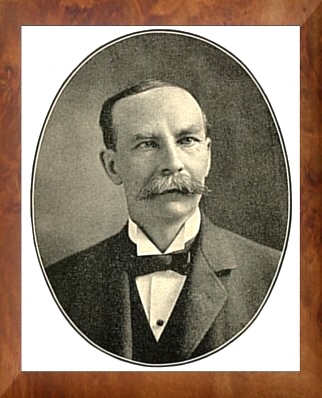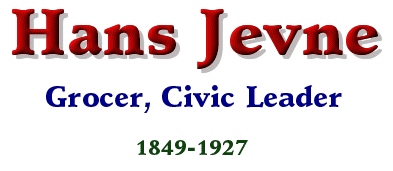


 |
|
|
Reprinted from the Jan. 11, 2007, issue of the Metropolitan News-Enterprise REMINISCING (Column) Norwegian Immigrant Operates Premier L.A. Grocery Store
Supreme among grocery stores west of the Mississippi a century ago was H. Jevne’s. It was located right here, where I’m now plunking out this column, at 210 S. Spring Street…the location since 1990 of Metropolitan News Company offices. I have no idea what was being sold at this spot where my desk and PC are now. Caviar? Wines? Laundry soap? Cheeses? Perfumes? Mops? Candles? Jevne had them all. Here’s an ad which appeared 100 years ago today in the Los Angeles Times featuring smoked bloaters:
Aside from Jevne ads appearing in the local dailies, they were to be found in out-of-state newspapers. Residents elsewhere were urged to send away for a free catalog and place their orders for shipping, or take the train to L.A. to stock up on merchandise. “Buy Groceries in Los Angeles.” That was the heading on a June 18, 1901 Jevne ad published in the Arizona Republic, which continues: “Go to Jevne’s for hundreds of dainty delicacies that no other grocery store in the Pacific southwest carries....Make a list before you leave on a trip to the coast.” A July 17, 1901 ad in the same newspaper advises: “Free writing and waiting room at Jevne’s in Los Angeles. Have your mail addressed in our care. Come to us for any information you wish. Use us in any way you can. We’re always glad to make strangers welcome no matter if you wish to buy groceries, wines or cigars of us or not….” I don’t recall seeing any such an invitation in recent Ralphs, Vons or Albertson’s ads. “Buy enough [groceries] to last six months or a year,” an Aug. 8, 1901 ad in the Arizona newspaper suggests. A steadily growing number of H. Jevne products, such as Jevne Coffee, La Crescenta Olive Oil, and Pot o’ Gold Oranges, were available in the early 1900s in grocery stores in Southern California, Arizona, and New Mexico. The proprietor of H. Jevne Co. was Hans Jevne, born Feb. 28, 1849 in Hamar, Norway. On Oct. 18, 1866, he and his brother Carl came to Chicago to go to work for their older brother, who ran a Norwegian food market. Odd S. Lovoll, in his 1999 book, “The Promise Fulfilled: A Portrait of Norwegian-Americans Today,” makes mention of that establishment: “Norwegian food items were offered to the Norwegian community at immigrant retail stores, such as the one opened in 1865 by the young Christian H. Jevne. Jevne expanded to become a large wholesale and import concern, importing cheese, fish, canned goods, and aquavit directly from Norway.” Operations expanded, and the store came to serve the populace at large. The first electric light in Chicago is said to have been installed there in 1880, and the store utilized two novel devices: an electric coffee bean roaster and an electric coffee mill. Hans Jevne worked “first as salesman and afterward as manager in his brother’s mammoth establishment, for seventeen years—with but ten days’ vacation,” according to “Illustrated history of Los Angeles County, California,” published in 1889. In that capacity, the book notes, Jevne became a “master of the grocery trade in every detail.” Moving with his wife and 7-year old son to the West Coast in February 1882, for sake of his wife’s health, and to Los Angeles the following November, Jevne opened a small shop on North Spring Street, soon shifting to a larger space nearby, and in 1896 relocating to the recently opened Wilcox Building at South Spring and Second Streets. The southern portion of the building where Jevne had his store, and where we now have our offices, was, prior to erection of the building, site of the Empire Livery Stable. “A History of the Norwegians of Illinois,” published in 1905, says that Jevne, as a Los Angeleno, “has grown up, so to speak, with the town, has prospered, and now owns one of the largest as well as the best equipped stores in the country.” There will be more about Jevne next week. Copyright 2007, Metropolitan News Company Reprinted from the March 1, 2007, issue of the Metropolitan News-Enterprise REMINISCING (Column) Jevne: Retail Grocer, Wholesaler, Bank Director, Civic Leader When Norwegian immigrant Hans Jevne first opened up shop in downtown Los Angeles in November 1882, in a small space now within the confines of City Hall, selling groceries to members of the public was his only pursuit. As his business expanded, as he became an “American success story”—to use a once hackneyed and now arcane phrase—his interests multiplied…though his primary and most visible role remained that of a retail grocer. Jevne “was always on the main floor” of his store, “giving a kind smile and a glad hand of welcome to all who entered his door,” Herman W. Frank writes in “Scrapbook of a Western Pioneer,” published in 1934. But Frank (a founder of Harris & Frank clothiers) goes on to point to another side of Jevne, saying he was “the type of man with a civic spirit that helped build Los Angeles and the Los Angeles Chamber of Commerce.” Jevne was one of the organizers of the Chamber of Commerce in
1888, a time when the city was experiencing a drastic decrease in
population…set then at about 50,000, down from 70,000 in 1880. Among of the
group’s early efforts was that of seeking to lure mid-west and southern farmers
here by means of an exhibition dubbed “California on Wheels,” located in a
railway car. The car traveled through the farm regions over a two-year period,
displaying agricultural products of this state. As a civic leader, Jevne pushed for causes—such as adoption of a city charter and construction of a deep water harbor in San Pedro—but didn’t care to involve himself in partisan politics. His business interests were varied. The one that went hand-in-hand with the retail grocery operation was his wholesale venture which encompassed the manufacturing of his own brands of products, including Pot ’O’ Gold oranges. He produced La Crescenta brand olive oil and was involved in quite a different sort of oil as a director of Western Union Oil Co. and Edmonds Midway Oil Co. Many of his activities were conducted in the Wilcox Building, at Second and Spring streets. The building was opened in 1896, and Jevne had the space on the first floor at the south end of it (where, as I’ve noted, this newspaper now has its offices). On the evening of July 20, 1896—one week before H. Jevne Company opened its new store there—the Merchants and Manufacturers Assn. dedicated its offices in the building and celebrated the formation of its organization, an amalgamation of two existing groups. Jevne had been active in the Merchants’ Association, serving on the Executive Committee, and was to be a key player in the fused alliance. He continued to play a major role in the staging of the annual Fiesta de Los Angeles which brought money into the city and was a leader of the group’s opposition to an occupational license tax. On the fifth floor was the California Club, of which Jevne was a charter member, a place where business was transacted over brandy and cigars. The first-floor corner space came to be occupied in 1901 by First National Bank of Los Angeles, of which Jevne was a director. (Among the other directors of the bank were real estate investor Henry Huntington, who owned much of the county’s electric railway system; Walter J. Trask, a founder of the law firm that became Gibson, Dunn & Crutcher and who was to serve as Los Angeles Bar Assn. president in 1910; C.H. Sessions whose 400-acre dairy ranch adopted the maiden name of his wife, Lynne Wood, with the land later becoming the City of Lynwood; and Jared S. Torrance who was to found the City of Torrance.) “He was not only one of the city’s most substantial business men,” the 1932 book “California and Californians” says of Jevne, “but a citizen who took a keen and intelligent interest in the affairs of his community.” Harris Newmark—a leading merchant, a founder of Montebello, and an organizer of the Los Angeles Public Library—says in his 1916 book, “Sixty Years in Southern California,” that “Jevne, since his advent here, has been identified with the most important steps in the evolution of the city.” Copyright 2007, Metropolitan News Company
|
CLICK BELOW TO RETURN TO THE...